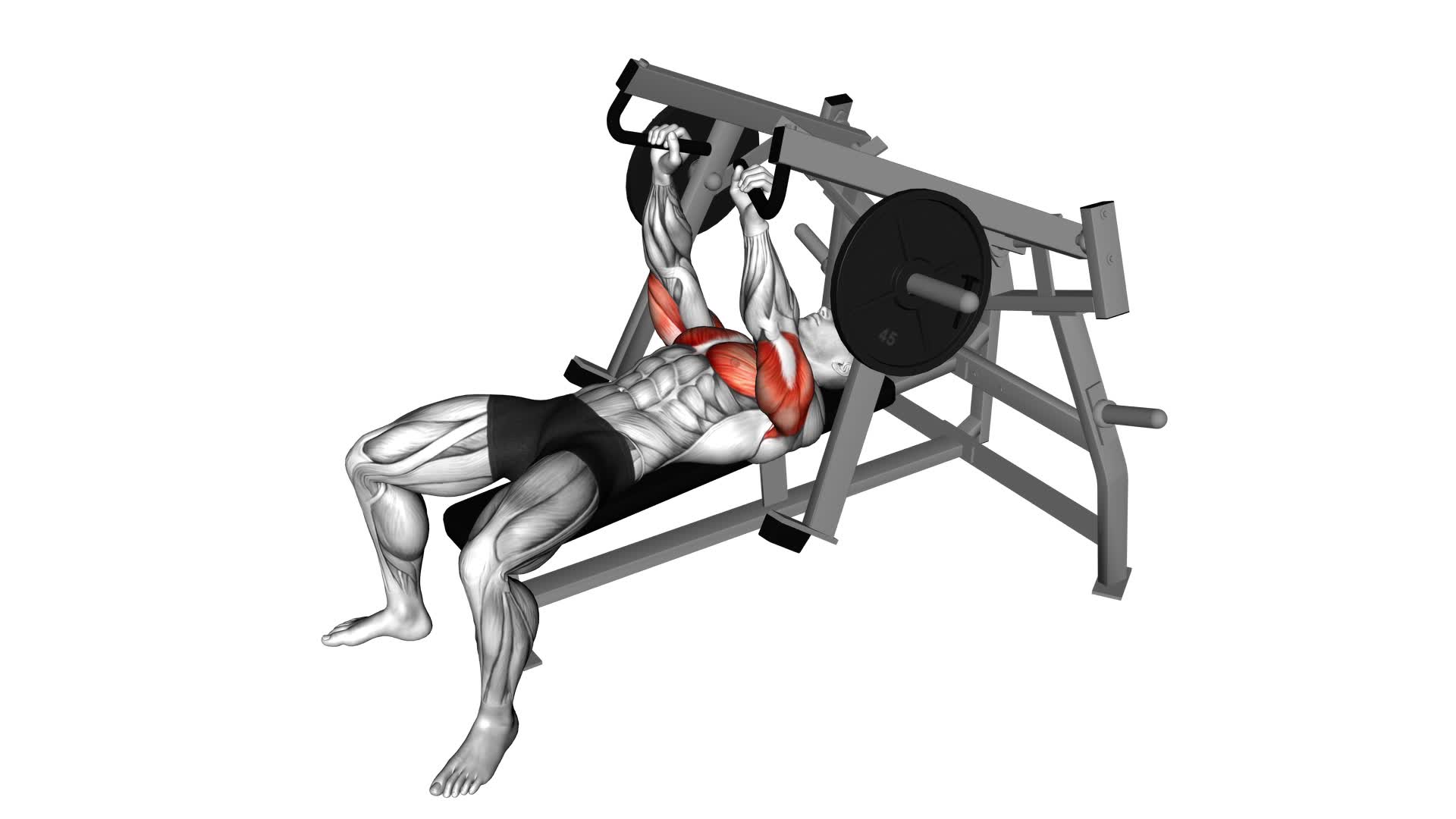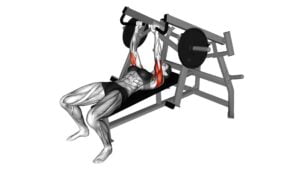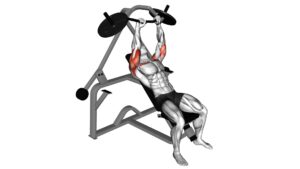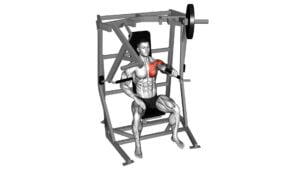Lever Lying Chest Press (Plate Loaded) – Video Exercise Guide & Tips

Looking to strengthen your chest muscles? The lever lying chest press (plate loaded) is a great exercise to add to your routine. In this video exercise guide, you'll learn the proper form and technique to target your chest effectively.
Watch This Exercise Video
With variations and modifications, you can tailor the exercise to your fitness level. Maximize your gains and avoid common mistakes with expert tips.
Get ready to feel the burn and see results with this dynamic chest press workout.
Key Takeaways
- Plate-loaded lever chest press machines provide a greater range of motion and more control over the amount of weight used.
- Proper form and technique include adjusting seat and backrest height, maintaining a neutral grip and straight wrists, and engaging the core throughout the exercise.
- The primary muscle activated in the lever lying chest press is the pectoralis major, with involvement from the anterior deltoids and triceps brachii muscles.
- Variations and modifications of the exercise include adjusting hand position on the handles, using a wider or narrower grip to target different areas of the chest, and customizing the exercise based on individual goals and preferences.
Equipment and Setup
To perform the Lever Lying Chest Press (Plate Loaded) exercise, you'll need an adjustable bench and a plate-loaded lever chest press machine. Plate loaded machines offer several benefits compared to other types of weight machines. Firstly, they allow for more natural and unrestricted movements, mimicking real-life actions and engaging multiple muscle groups simultaneously. This can lead to improved functional strength and better overall muscle development. Additionally, plate loaded machines provide a greater range of motion, allowing for better muscle targeting and increased muscle activation. They also allow for more control over the amount of weight being used, as you can easily add or remove plates to adjust the resistance.
If you don't have access to a plate-loaded lever chest press machine, there are alternative exercises you can do to target your chest muscles. One popular option is the dumbbell chest press, where you lie on a bench and press dumbbells up towards the ceiling. This exercise also engages the stabilizing muscles in your shoulders and core.
Another alternative is the push-up, which can be done anywhere and requires no equipment. Push-ups not only target the chest muscles but also engage the triceps and shoulders. Incorporating these exercises into your routine can help you build a strong and well-rounded chest.
Proper Form and Technique
When performing the Lever Lying Chest Press (Plate Loaded) exercise, it's important to maintain proper form and technique to prevent injuries and maximize muscle activation.
To ensure proper form, start by adjusting the seat and backrest height so that your feet are flat on the floor and your chest is aligned with the handles. Grab the handles with a neutral grip, keeping your wrists straight. Engage your core and press your back into the bench throughout the exercise.
As you begin the movement, exhale and push the handles away from your body until your arms are fully extended, but avoid locking out your elbows. Maintain control and avoid bouncing the weight off your chest. As you lower the weight, inhale and bring the handles back towards your body, allowing your elbows to bend to a 90-degree angle.
To prevent injury, avoid excessive arching of the lower back or lifting your hips off the bench during the exercise. Keep your shoulders stable and avoid shrugging or rounding them forward. Focus on engaging your chest muscles throughout the movement by squeezing them at the top of the exercise.
Targeted Muscles
Engage your chest muscles throughout the Lever Lying Chest Press (Plate Loaded) exercise to target and strengthen your pectoral muscles. This exercise is highly effective for muscle activation and offers numerous exercise benefits.
Here are four key muscles that are targeted during the Lever Lying Chest Press:
- Pectoralis Major: The primary muscle activated during this exercise is the pectoralis major, which is responsible for the movement of your arms across your body. By engaging this muscle, you can enhance the strength and size of your chest.
- Anterior Deltoids: The front part of your shoulder, known as the anterior deltoids, also gets activated during the Lever Lying Chest Press. Strengthening these muscles can improve shoulder stability and contribute to an overall well-rounded upper body.
- Triceps Brachii: While the main focus is on the chest, the triceps brachii muscles on the back of your upper arms are also engaged during this exercise. Working these muscles can enhance arm strength and give your arms a more defined appearance.
- Serratus Anterior: The serratus anterior muscles, located on the sides of your chest, are involved in stabilizing your shoulder blades during the Lever Lying Chest Press. Strengthening these muscles can improve your posture and help prevent shoulder injuries.
Variations and Modifications
To modify the Lever Lying Chest Press exercise, you can adjust the position of your hands on the handles. By changing the width of your grip, you can target different areas of your chest muscles. A wider grip focuses more on your outer chest, while a narrower grip targets the inner chest. This variation allows you to customize the exercise based on your individual goals and preferences.
In addition to variations for different fitness levels, the Lever Lying Chest Press can also be modified for individuals with injuries. If you have a shoulder injury or limited mobility, you can use a neutral grip, where your palms face each other instead of facing forward. This grip reduces the stress on your shoulders and allows you to still work your chest effectively.
For those with lower back issues, it's recommended to perform the exercise with bent knees or place a small towel or pad under your lower back for support. This modification helps to alleviate stress on the lower back and maintain proper form throughout the movement.
Tips for Maximizing Gains
To maximize your gains, focus on maintaining proper form and gradually increasing the weight used during the Lever Lying Chest Press exercise. Here are some tips to help you maximize your strength and achieve progressive overload:
- Perfect your form: Before increasing the weight, ensure that you have mastered the correct technique. This won't only prevent injuries but also engage the targeted muscles more effectively.
- Start with a comfortable weight: Begin with a weight that challenges you but allows you to maintain proper form throughout the exercise. This will lay a solid foundation for future progress.
- Gradually increase the weight: Once you have mastered the correct form, gradually increase the weight used during each session. This gradual progression will stimulate muscle growth and maximize your strength gains.
- Listen to your body: Pay attention to how your body feels during the exercise. If you experience pain or discomfort, reduce the weight or take a break. Pushing through pain can lead to injuries and hinder your progress.
Common Mistakes to Avoid
To avoid common mistakes during the lever lying chest press, it's important to pay attention to your hand placement and breathing technique.
Incorrect hand placement can put undue stress on your wrists and shoulders, so make sure your hands are positioned correctly on the handles.
Additionally, improper breathing technique can decrease the effectiveness of the exercise, so remember to exhale as you push the weight away and inhale as you bring it back towards your chest.
Incorrect Hand Placement
Are you placing your hands correctly during the Lever Lying Chest Press (Plate Loaded) exercise? Proper hand positioning is crucial for injury prevention and maximizing the effectiveness of this exercise. Here are four key points to keep in mind:
- Hand placement: Make sure your hands are positioned slightly wider than shoulder-width apart on the handles of the lever press machine. This will provide stability and control throughout the movement.
- Grip strength: Maintain a firm grip on the handles without gripping too tightly. This will help you maintain control and prevent unnecessary strain on your wrists.
- Wrists alignment: Keep your wrists in a neutral position, neither flexed nor extended. This will help distribute the load evenly and minimize the risk of wrist injuries.
- Elbow positioning: Keep your elbows at a 90-degree angle, aligning them with your shoulders. This will engage your chest muscles effectively and prevent excessive strain on your shoulders.
Now that you have mastered the correct hand placement, let's move on to the next important aspect of the Lever Lying Chest Press exercise: improper breathing technique.
Improper Breathing Technique
When performing the Lever Lying Chest Press (Plate Loaded) exercise, it's important to be aware of the common mistake of improper breathing technique. Proper breathing patterns play a crucial role in maximizing the effectiveness of your workout and preventing potential injuries.
Improper breathing can lead to decreased performance, reduced oxygen intake, and increased fatigue. When executing the exercise, it's recommended to inhale deeply before initiating the press and exhale forcefully as you push the weight away from your body.
This breathing pattern helps stabilize your core and maintain proper form throughout the movement. By maintaining a consistent and controlled breathing pattern, you can optimize your muscle activation and enhance your overall strength and endurance during the Lever Lying Chest Press exercise.
Frequently Asked Questions
How Much Weight Should I Start With on the Lever Lying Chest Press?
When starting the lever lying chest press, it's important to choose an appropriate starting weight that challenges you but allows for proper form. Begin with a weight that you can comfortably lift for 8-12 repetitions with good technique.
This will ensure that you're working your chest muscles effectively without sacrificing form. As you become stronger, gradually increase the weight to continue progressing and challenging yourself.
Can I Do the Lever Lying Chest Press if I Have Shoulder or Back Injuries?
If you have shoulder or back injuries, it's important to be cautious when doing the lever lying chest press. This exercise can put strain on those areas, so modifications are recommended.
Instead, focus on shoulder injury modifications, such as using lighter weights or resistance bands.
For back injuries, alternative exercises like dumbbell chest presses or push-ups can be safer options.
Remember to consult with a professional or physical therapist for personalized recommendations.
How Often Should I Incorporate the Lever Lying Chest Press Into My Workout Routine?
To effectively incorporate the lever lying chest press into your workout routine, consider your fitness goals and current program. The lever lying chest press is a great exercise for targeting your chest muscles and improving upper body strength.
It's recommended to perform this exercise 2-3 times a week, allowing for adequate rest and recovery between sessions. Remember to start with lighter weights and gradually increase as you progress.
The lever lying chest press offers numerous benefits, such as improved muscle definition and increased upper body power.
Is It Necessary to Have a Spotter When Performing the Lever Lying Chest Press?
When doing the lever lying chest press, you might wonder if a spotter is necessary. While having a spotter can provide an extra level of safety, it isn't absolutely necessary for this exercise.
However, if you're lifting heavy weights or are new to this exercise, it's a good idea to have someone there to assist you.
The lever lying chest press offers many benefits, such as targeting your chest muscles and improving upper body strength.
Can I Perform the Lever Lying Chest Press With Dumbbells Instead of a Plate-Loaded Machine?
Yes, you can perform the lever lying chest press with dumbbells instead of a plate-loaded machine. This exercise is known as the dumbbell variation of the lever lying chest press. It offers similar benefits as the plate-loaded machine, such as targeting your chest muscles and improving upper body strength.
Using dumbbells allows for greater range of motion and engages stabilizer muscles. Just make sure to maintain proper form and start with a weight that challenges you but is manageable.
Conclusion
In conclusion, the lever lying chest press is an effective exercise for targeting the chest and upper body muscles. By using proper form and technique, you can maximize gains and avoid common mistakes.
Additionally, variations and modifications can be incorporated to add variety and challenge to your workout routine.
Remember to always use the appropriate equipment and setup to ensure safety and effectiveness.
Keep pushing yourself and enjoy the benefits of this plate loaded exercise.

Author
Years ago, the spark of my life’s passion ignited in my mind the moment I stepped into the local gym for the first time. The inaugural bead of perspiration, the initial endeavor, the very first surge of endorphins, and a sense of pride that washed over me post-workout marked the beginning of my deep-seated interest in strength sports, fitness, and sports nutrition. This very curiosity blossomed rapidly into a profound fascination, propelling me to earn a Master’s degree in Physical Education from the Academy of Physical Education in Krakow, followed by a Sports Manager diploma from the Jagiellonian University. My journey of growth led me to gain more specialized qualifications, such as being a certified personal trainer with a focus on sports dietetics, a lifeguard, and an instructor for wellness and corrective gymnastics. Theoretical knowledge paired seamlessly with practical experience, reinforcing my belief that the transformation of individuals under my guidance was also a reflection of my personal growth. This belief holds true even today. Each day, I strive to push the boundaries and explore new realms. These realms gently elevate me to greater heights. The unique combination of passion for my field and the continuous quest for growth fuels my drive to break new ground.







